How to Make a Snake Plant Fuller and Bushier
Snake plants are low-maintenance favorites, but with the right techniques, you can take their growth from scraggly to stunning. This guide reveals proven tips to encourage lush, full foliage and maximize your snake plant’s bushy potential. From lighting and watering routines to soil mixes, fertilization, pruning, propagation, and environmental adjustments, you’ll gain valuable insights to unlock fuller, more luxuriant growth. Transform that sparse plant into an eye-catching statement piece with these step-by-step strategies for achieving a truly fabulous, thriving snake plant.
Contents
Provide Optimal Lighting Conditions
For ideal growth and fullness, snake plants thrive in bright, indirect light. Place your plant near a north-facing window or a few feet away from a south-facing one. If you’re using artificial light, position grow lights about 6-12 inches above the plant for 12-14 hours daily. Avoid direct sunlight, as it can scorch the leaves. In low-light conditions, your snake plant will survive but grow slower and less bushy. To promote fuller growth, rotate your plant every few weeks to guarantee all sides receive equal light exposure. If you notice the plant leaning towards the light source, it’s a sign it needs more balanced lighting. By providing ideal light conditions, you’ll encourage your snake plant to produce more leaves and become bushier, enhancing its overall appearance and health.
Maintain Proper Watering Schedule
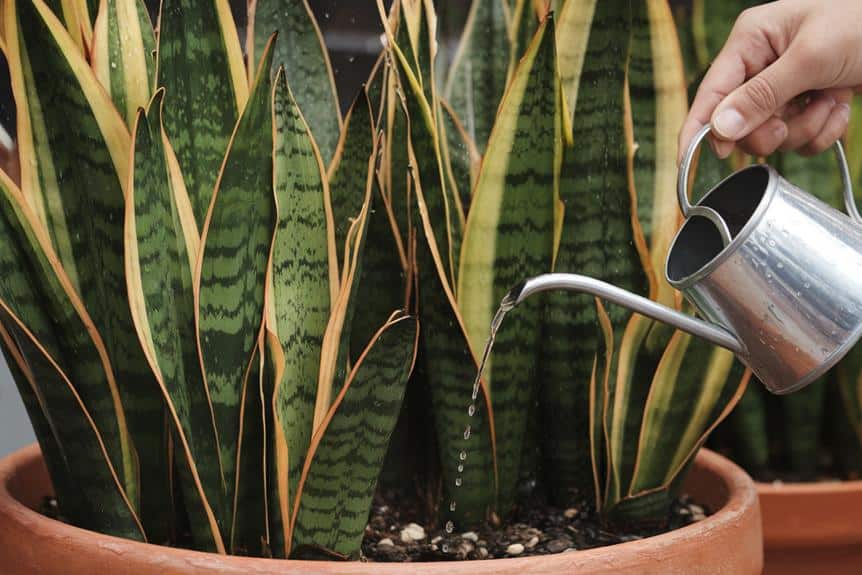
While proper lighting sets the stage for a fuller snake plant, maintaining an appropriate watering schedule is key to its bushy growth. Snake plants are drought-tolerant, so it’s imperative to avoid overwatering. Water your plant thoroughly, but only when the soil has completely dried out. During the growing season (spring and summer), this might be every 2-3 weeks, while in winter, you may only need to water once a month.
To encourage fuller growth, water from the bottom by placing the pot in a tray of water for about 15 minutes. This method promotes deeper root growth, resulting in a bushier plant. Always guarantee proper drainage to prevent root rot. By following this watering regimen, you’ll help your snake plant develop a robust root system and lush foliage, serving as a beautiful addition to any space.
Use Well-Draining Soil Mix
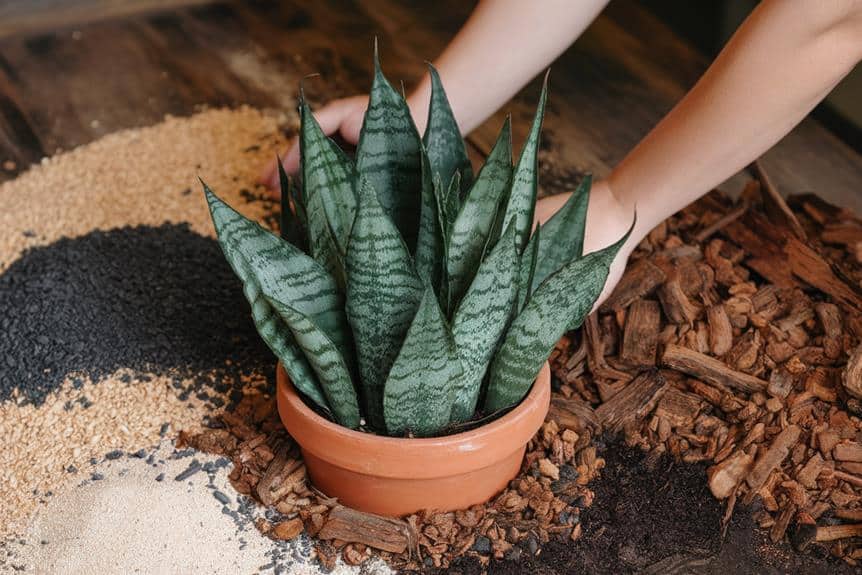
When it comes to promoting fuller growth in your snake plant, the soil mix you use plays an essential role. Opt for a well-draining potting mix that combines equal parts of peat moss, perlite, and coarse sand. This blend guarantees proper aeration and prevents water retention, which can lead to root rot.
You can also create your own mix by combining regular potting soil with coarse materials like orchid bark or pumice. This custom blend will provide the ideal balance of moisture retention and drainage that snake plants thrive in.
When repotting, gently loosen the root ball and remove any dead or rotting roots. Place the plant in its new pot with fresh, well-draining soil, ascertaining the crown sits just above the soil line. This practice encourages new growth and helps your snake plant become fuller and bushier over time.
Fertilize Strategically
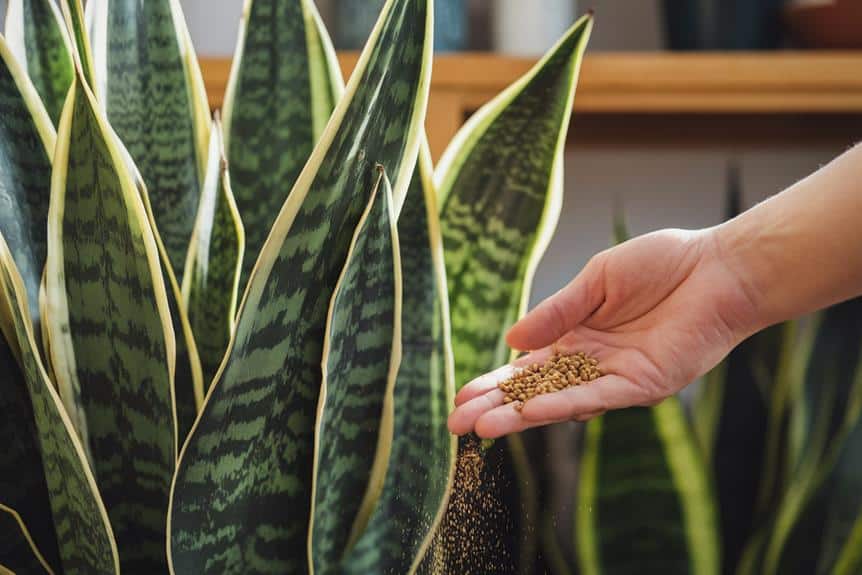
Proper soil composition sets the stage for healthy growth, but strategic fertilization takes your snake plant’s fullness to the next level. During the growing season (spring and summer), feed your snake plant with a balanced, water-soluble fertilizer diluted to half-strength once a month. Choose a fertilizer with an NPK ratio of 10-10-10 or 5-5-5 to provide essential nutrients without overwhelming the plant.
Avoid fertilizing in fall and winter when the plant’s growth slows. Over-fertilization can lead to leggy growth, so it’s pivotal to strike a balance. If you notice yellowing leaves or stunted growth, reduce the frequency of fertilization. Remember, snake plants are adaptable and can thrive with minimal care, so err on the side of under-fertilizing rather than over-fertilizing. By nourishing your plant strategically, you’ll encourage fuller, bushier growth that enhances its beauty and air-purifying capabilities.
Prune for Fuller Growth
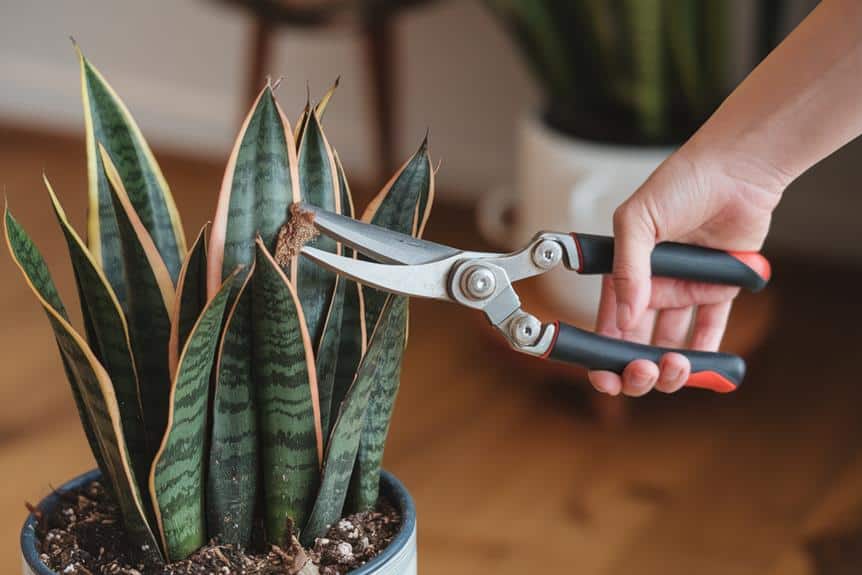
Regularly pruning your snake plant encourages fuller, bushier growth. To prune effectively, start by inspecting your plant for any damaged, yellowing, or dead leaves. Using clean, sharp scissors or pruning shears, cut these leaves off at the base, close to the soil. This helps redirect energy to healthy growth.
For a bushier appearance, you can trim some of the taller leaves. Cut them at varying heights to create a more natural look. Don’t remove more than one-third of the plant at once to avoid stressing it.
After pruning, your snake plant may look a bit sparse, but don’t worry. This temporary setback will result in new growth and a fuller plant. Remember to clean your tools between cuts to prevent the spread of diseases. With regular pruning, you’ll soon have a lush, thriving snake plant to enjoy and share.
Propagate to Increase Density
Along with pruning, propagation is a powerful technique to make your snake plant fuller and bushier. To propagate, you’ll need to divide the plant or take leaf cuttings. For division, carefully remove the plant from its pot and separate the rhizomes, ensuring each section has roots and leaves. Replant these divisions in the same container or new pots filled with well-draining soil.
For leaf cuttings, cut a healthy leaf into 3-4 inch sections, remembering which end was closest to the soil. Plant these cuttings vertically in a moist, well-draining potting mix, with the end that was closest to the soil inserted about an inch deep. Keep the soil slightly moist and place the cuttings in bright, indirect light. In a few weeks, new growth will emerge, creating a fuller, bushier appearance for your snake plant.
Rotate Plant Regularly
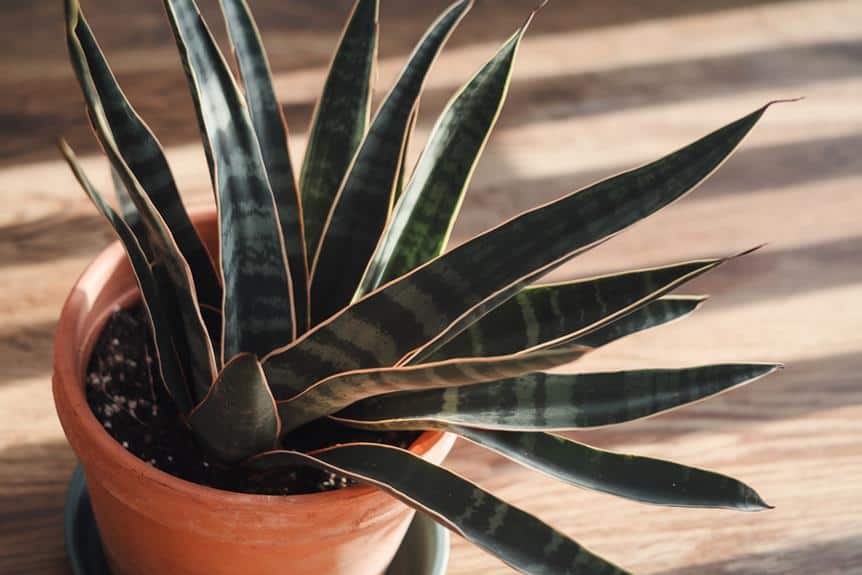
To guarantee your snake plant grows evenly and preserves a balanced shape, you’ll need to rotate it regularly. Turn your plant a quarter of the way every week to confirm all sides receive equal light exposure. This practice prevents the plant from leaning towards the light source and encourages uniform growth. If you notice one side becoming fuller than the other, position that side away from the light to promote growth on the less-developed side.
For those with multiple snake plants, consider swapping their positions periodically. This not only helps maintain even growth but also allows you to share different light conditions among your plants. Remember, consistency is key when rotating your snake plant. Set a reminder on your phone or calendar to make this task a regular part of your plant care routine. Your dedication will result in a fuller, bushier, and more aesthetically pleasing snake plant.
Control Pests and Diseases

Vigilance is imperative when it comes to controlling pests and diseases in your snake plant. Regularly inspect your plant for signs of infestation or illness, such as discolored leaves, spots, or small insects. If you notice any issues, act quickly to prevent spread. For common pests like mealybugs or spider mites, wipe the leaves with a mixture of water and mild soap. For fungal infections, remove affected parts and treat with a fungicide. Guarantee proper air circulation and avoid overwatering to prevent root rot. If you’re serving others by maintaining communal plants, consider using natural pest control methods to keep the environment safe. Remember, a healthy snake plant is more resistant to pests and diseases, so maintain ideal growing conditions. By staying proactive, you’ll keep your snake plant thriving and fuller.
Repot When Necessary
Repotting is another key factor in maintaining a fuller, bushier snake plant. You’ll want to repot your snake plant every 2-3 years or when it outgrows its current container. Choose a pot that’s 1-2 inches larger in diameter than the previous one, ensuring it has drainage holes. Use a well-draining potting mix specifically designed for succulents.
When repotting, gently remove the plant from its old container, loosening the roots if they’re compacted. Trim any dead or rotting roots before placing it in the new pot. Fill in with fresh soil, ensuring the plant sits at the same depth as before. After repotting, water thoroughly and place the plant in a bright, indirect light location. This process encourages new growth and helps your snake plant become fuller and bushier over time.
Adjust Room Temperature and Humidity
Snake plants thrive in specific temperature and humidity conditions, which you can easily adjust to promote fuller, bushier growth. Keep room temperatures between 60-80°F (15-27°C) for desirable results. These plants prefer warm environments but can tolerate cooler temperatures. Avoid exposing them to drafts or sudden temperature changes.
Maintain moderate humidity levels around 40-50%. While snake plants are drought-tolerant, they’ll benefit from occasional misting or placing a humidity tray nearby. In dry climates, you can use a humidifier to increase moisture levels. However, be cautious not to overdo it, as excessive humidity can lead to root rot.
Monitor your plant’s response to these adjustments. If you notice improved growth and fuller appearance, you’re on the right track. Remember, consistency is key when creating an ideal environment for your snake plant to flourish and serve as a beautiful addition to your space.
